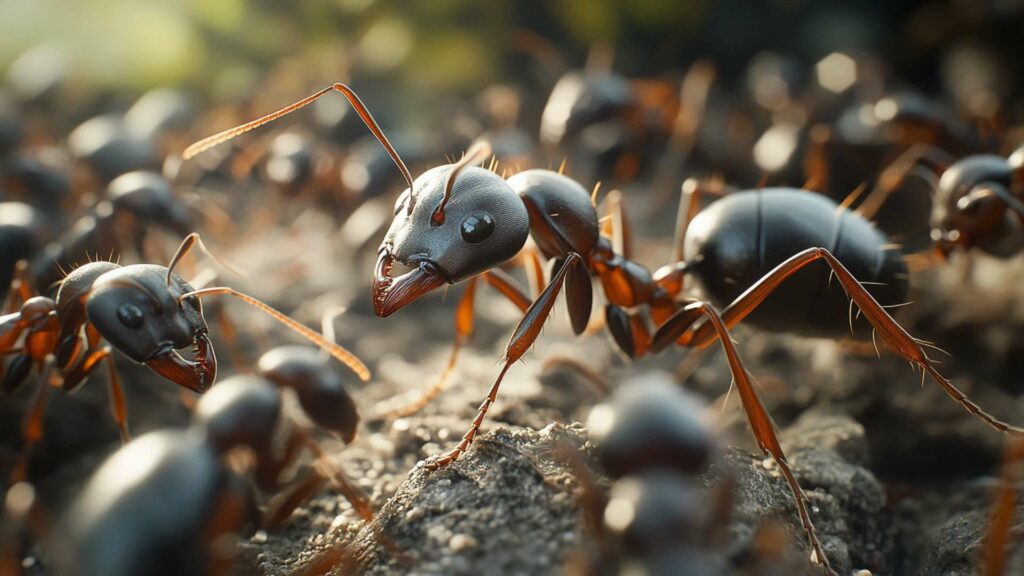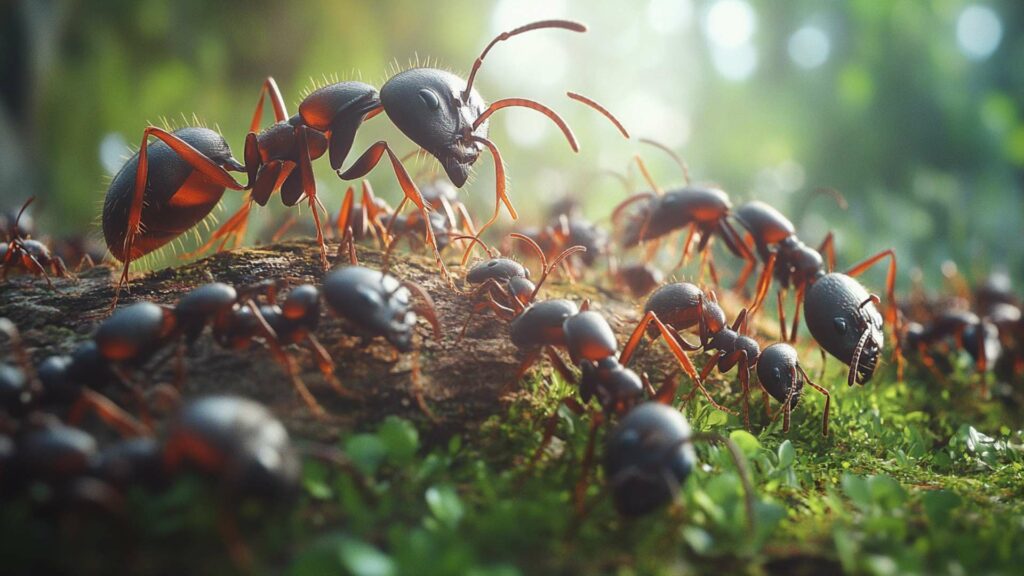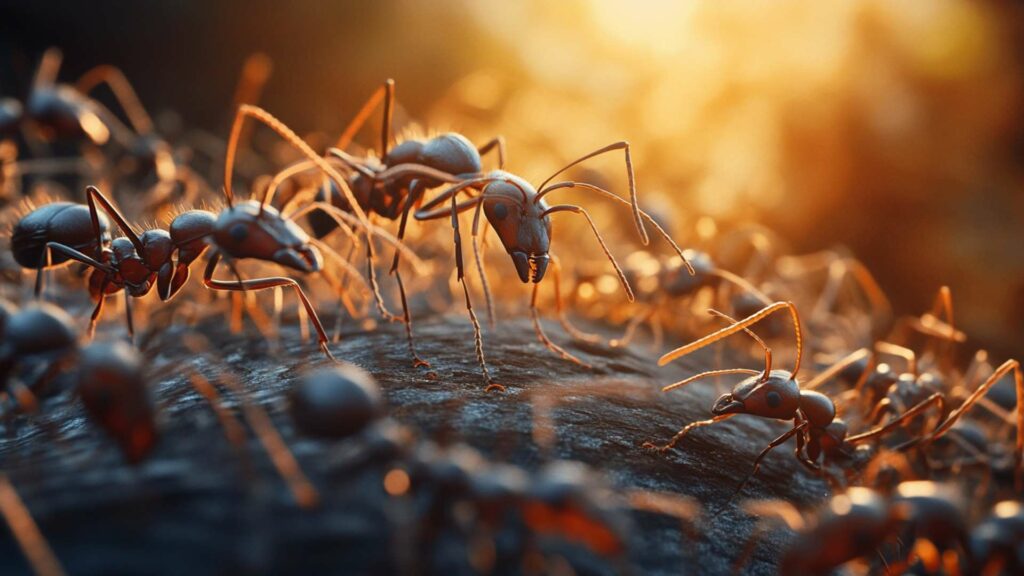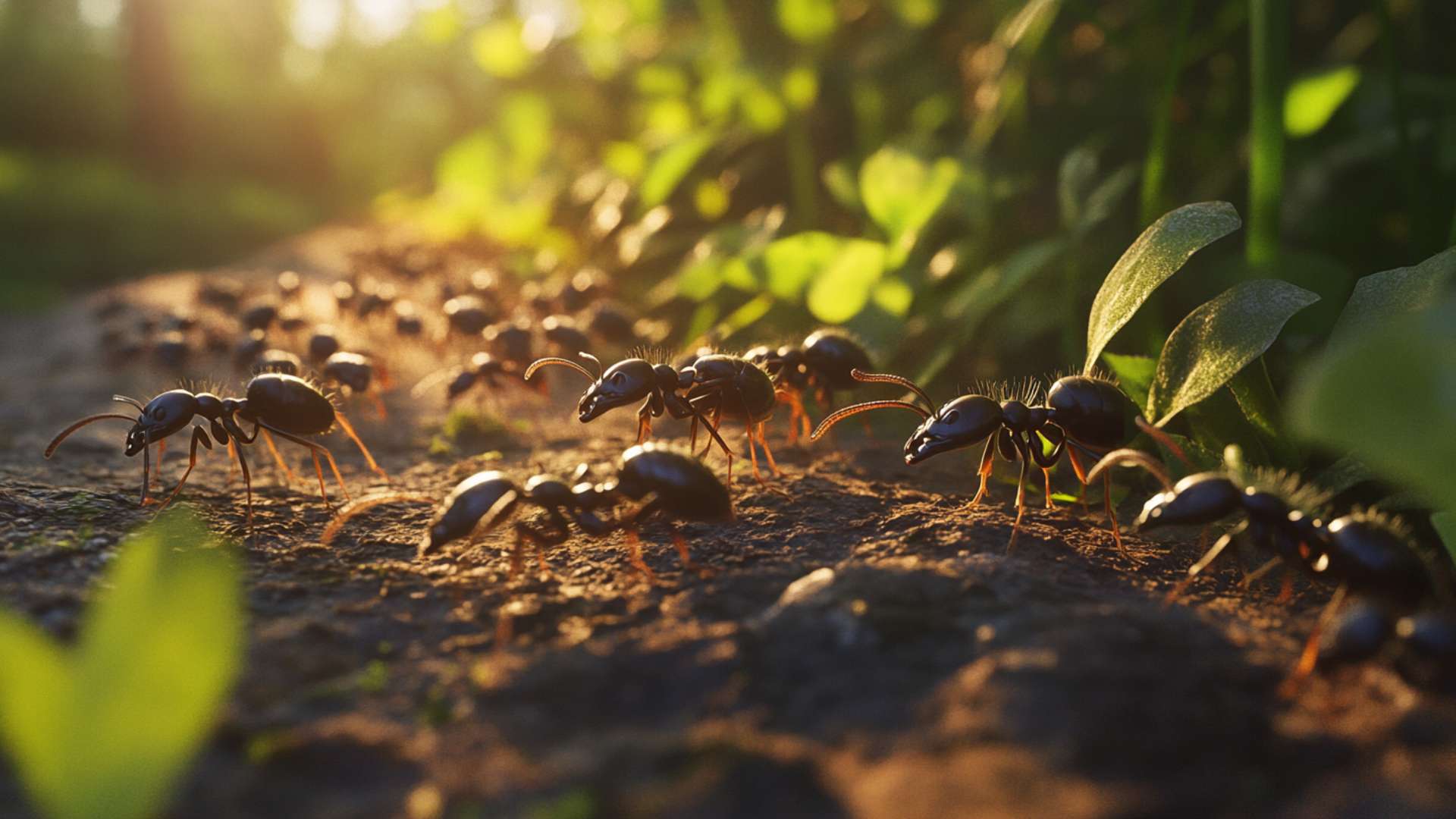Carpenter ants are fascinating creatures that play a significant role in our ecosystem. They belong to the genus Camponotus and are known for their ability to excavate wood and create elaborate nests within it.
Unlike termites, which feed on the wood they consume, carpenter ants do not actually eat wood. Instead, they hollow out the wooden structures in which they establish their colonies, making them a potential concern for homeowners.
Brief Overview of Carpenter Ants

Carpenter ants come in various shapes and sizes, but most species typically measure between ¼ to ¾ of an inch in length. They have different color variations depending on the species, ranging from shades of red and black to dark brown or even a combination of these hues. One particularly common species is the black carpenter ant (Camponotus pennsylvanicus), known for its large size and dark coloration.
These ants have distinct body parts: head, thorax, abdomen with a narrow waist called petiole (which distinguishes them from termites), antennae, legs, and mandibles. Understanding their appearance is crucial because it allows us to identify them accurately and differentiate them from other ant species or potentially destructive pests like termites.
Importance of Understanding Their Appearance
Being able to recognize a carpenter ant nest and ants by their appearance is essential for several reasons. First and foremost, identifying these ants correctly enables homeowners to take appropriate action if an infestation is suspected. By promptly recognizing the signs of carpenter ant activity such as sawdust-like frass around wooden structures or rustling sounds emanating from walls or ceilings during nighttime hours when worker ants are most active—the homeowner can seek professional assistance from a pest management professional. Additionally understanding the carpenter ants’ appearance also helps in controlling and preventing further infestations.
A thorough inspection of the property by an extension entomologist or a skilled pest management professional can determine if there are satellite colonies, which are smaller subsidiary colonies connected to the parent colony. By locating and addressing these satellite colonies, it becomes easier to control carpenter ants and prevent them from causing significant structural damage.
Furthermore, recognizing the appearance of carpenter ants aids in differentiating them from other ant species. This distinction is vital because control methods can vary depending on the type of ant infestation.
For instance, while some carpenter ants may be harmless and merely annoying, others may pose a threat to one’s property or health. Therefore, proper identification enables homeowners to implement appropriate measures that target the specific carpenter ant species causing concern.
General Appearance of Carpenter Ants

The Size and Color Variations
When it comes to carpenter ants, size and color can vary greatly. These industrious insects can range in size from about ¼ inch to a whopping one inch! Some species of carpenter ants even have workers that are bigger than others, making carpenter ants truly diverse in their size.
As for their color, most species exhibit shades of black or brown, but some may have reddish or yellowish hues. This wide range of colors adds to the fascinating nature of these formidable creatures.
Distinct Body Parts: Head, Thorax, Abdomen
Carpenter ants possess a well-defined body structure consisting of three distinct parts: the head, thorax, and abdomen. The head is relatively large and noticeable with its six tiny legs emerging from the thorax below it. The thorax acts as the midsection connecting the head tree limbs and abdomen and is composed of three segments.
It is responsible for housing the muscles that control their legs’ movements as they navigate through various environments. We have the abdomen – this segment at the rear end contains vital organs such as digestive systems and reproductive organs.
Antennae and Their Functions

One striking feature that sets carpenter ants apart is their straight antennae protruding from their heads with precision. These antennae serve multiple functions crucial to a carpenter ant’s survival in its environment. Firstly, they aid in detecting chemical signals released by other ants or potential food sources along their foraging trails.
Secondly, these finely-tuned sensory appendages help navigate dark areas by sensing changes in temperature and humidity levels around them. They allow communication within carpenter ant colonies where specialized chemicals known as pheromones play an essential role in coordinating various tasks.
Carpenter ants rely heavily on their antennae to interpret the world around them, and their straight antennae are a distinctive feature worth noting. These sensory organs play a significant role in the survival and success of carpenter ant colonies.
Overall, carpenter ants boast an intriguing appearance with size variations, distinct body parts, and highly functional antennae. Understanding these aspects is crucial not only for identifying carpenter ants correctly but also for appreciating their remarkable adaptations.
As we delve deeper into their fascinating world, we’ll explore their head and mandibles in the next section of our exploration. Stay tuned!
Head and Mandibles
Shape and Size of the Head
The head of a carpenter ant is a fascinating aspect of their appearance. It is relatively large compared to the rest of their body, giving them a distinct profile.
The shape of their head is somewhat triangular, tapering towards the front. It’s important to note that the size and shape can vary depending on the species, but in general, carpenter ants have proportionately larger heads.
Mandibles: Strong Jaws for Chewing Wood
One striking feature of carpenter ants’ heads is their powerful mandibles. These mandibles are like formidable jaws designed for chewing through wood.
They are sharp and robust, enabling these insects to carve galleries within timber effortlessly. The mandibles’ strength allows carpenter ants to excavate nesting sites in both the moist wood and decaying wood, which they use as shelter for themselves and their colonies.
Purpose of Mandibles in Carpenter Ants’ Lives
The mandibles play a vital role in the lives of carpenter ants. Apart from being used for chewing wood, they serve various purposes within an established colony. For instance, worker ants use these powerful jaws to defend against predators or rival ant species that encroach upon their territory.
The mandibles also aid in manipulating objects such as moving food or rearranging materials within the nest. In addition, carpenter ants rely on mandibles during communication with other members of their colony.
These insects have glands that can produce chemicals called pheromones, which are used to communicate information like food sources or alarm signals between individuals. By rubbing their mandibles together or using them to tap surfaces while releasing pheromones, carpenter ants convey messages effectively.
Understanding the remarkable features of a carpenter ant’s head and its mighty jaws provides valuable insights into how they interact with their environment and other colony members. These adaptations have allowed carpenter ants to thrive and establish their nests in various types of wood, making them a unique and intriguing species within the insect world.
Thorax and Legs
The Sturdy Thorax Structure
When observing carpenter ants closely, you’ll notice their distinct and well-defined thorax, which serves as the middle segment of their body. This thoracic region is noticeably segmented, consisting of three visible parts: the prothorax, mesothorax, and metathorax.
These segments provide flexibility and mobility to carpenter ants, allowing them to navigate through various environments with agility. The segmented thorax acts as a vital support system for the ant’s head and abdomen.
It gives them the necessary stability to perform their daily activities efficiently. So when you see that carpenter ant marching along your kitchen countertop or exploring your backyard fence post, remember that its sturdy thorax is the powerhouse behind its movements.
The Legs: Instruments of Movement and Navigation
Now let’s talk about those remarkable legs! As with most ants, carpenter ants have six legs in total – three pairs – attached to their thoracic region. Each leg consists of several segments known as tarsi, ending with tiny claws that assist in gripping surfaces.
Carpenter ant workers rely heavily on their legs for movement and navigation within their complex habitats. Their legs are specially adapted for diverse tasks such as foraging for food sources or finding shelter.
These versatile appendages allow them to scurry effortlessly across various surfaces like trees, walls, or even upside-down across ceilings! These agile limbs also play a crucial role in communication between worker ants.
By tapping on surfaces with their legs or engaging in delicate leg-to-leg interactions known as antennation, they convey important messages regarding the presence of food sources or potential threats within their surroundings. So next time you catch sight of a carpenter ant gracefully traversing your garden fence or scaling a tree trunk with ease using its impressive legwork – take a moment to appreciate the remarkable coordination and adaptability of these industrious insects.
Abdomen and Waist (Petiole)
Description of the rounded abdomen
When we think of carpenter ants, one of their most prominent features is their rounded abdomen. The abdomen, or the rear part of their body, is visibly larger and more robust compared to other insect parts.
This rounded shape is one of the key characteristics that distinguish carpenter ants from other ant species. In some cases, especially with black carpenter ants, the abdomen may appear glossy or shiny, which adds to their unique appearance.
The size and coloration of the abdomen can vary depending on the caste within a carpenter ant colony. For instance, queens have an enlarged abdomen that facilitates their vital role in egg-laying.
Their abdomens are noticeably bigger than those of worker ants or males. On the other hand, workers have smaller abdomens which allow them to perform various tasks within the colony efficiently.
Differences between males, females, and workers
The differences in abdominal size among carpenter ant castes reflect their distinct roles in a colony. Queens are responsible for reproduction and establishing new nests.
Their large abdomens contain specialized organs for producing eggs. This adaptation enables them to lay numerous eggs throughout their lifespan.
Workers, however, possess smaller abdomens adapted for different tasks such as foraging trails for food sources or maintaining and expanding the nest area. These dedicated workers tirelessly move through rotting wood or tree branches in search of sustenance for the entire colony.
Males, also known as drones, have an intermediate-sized abdomen compared to queens and workers. They are solely responsible for mating with potential queens during nuptial flights before starting new colonies.
Once mating is complete, male carpenter ants typically die shortly after fulfilling their reproductive purpose. Understanding these differences between castes aids in identifying individuals within a given colony since they each play distinct roles essential to the overall functioning of the carpenter ant society.
To tackle carpenter ant problems effectively, it is important to identify and locate their nests. Since the size and appearance of the abdomen differ among castes, this knowledge becomes valuable while searching for signs of infestation.
Carpenter ants feed on a variety of food sources like tree stumps or rotting wood, so inspecting these areas can lead you to their nest. If you find several carpenter ant nests or ants with large abdomens near a nest area, they are likely queens or males associated with a nearby colony.
Workers with smaller abdomens may be found foraging or traveling along established trails. Identifying and understanding these visual cues aids in implementing appropriate control measures to manage carpenter ant populations effectively.
In the next section, we delve into another intriguing aspect of carpenter ant appearance: Special Features – Wings and Winged Reproductives (Alates). Stay tuned!
Special Features: Wings and Winged Reproductives (Alates)

Types of Carpenter Ant Alates
Carpenter ant colonies produce winged male reproductives, known as alates, in order to expand their population and establish new colonies. These alates can be further categorized into two main types: male alates and female alates. Each type serves a specific purpose in the life cycle of carpenter ants.
Male Alates with Wings for Mating Purposes
Male carpenter ant alates are equipped with wings primarily for the purpose of mating. They are usually smaller than the females, measuring about half an inch in length. These males take flight during specific times of the year, searching for receptive females from nearby colonies or even other buildings.
They can often be seen swarming around light sources or congregating near potential mates. Once they find a compatible female, they engage in a brief courtship ritual before mating occurs.
Female Alates with Wings Before Establishing New Colonies
Female carpenter ant alates also possess wings but their purpose is slightly different from that of males. These future queens emerge from the parent nest with the ability to mate but their primary goal is to establish new colonies elsewhere. Female black garden ant alates are larger than males, measuring up to three-quarters of an inch in length.
Their wingspans can be quite impressive, spanning up to one and a half inches across when fully extended. The coloration of both male and female alate ants is generally darker than that of worker ants – ranging from reddish-brown to dark brown hues.
Differences from Other Castes
One notable difference between carpenter ant alates and other castes within the colony is their possession of wings. While workers lack wings entirely, both male and female alates have elongated wings that extend past their abdomen. The presence of wings allows them to venture further away from the primary nest, in search of suitable mates or new locations for establishing satellite colonies.
However, once the mating or colonizing process is complete, these wings are discarded. After mating, males die shortly after fulfilling their reproductive duty, while female alates shed their wings and begin to establish a new nest where they will become queens.
Carpenter ant alates play a crucial role in the life cycle and expansion of carpenter ant colonies. Understanding their distinct features, such as wing structures and coloration, can aid in identifying a potential carpenter ant infestation.
If you happen to come across winged ants around your property or within your home, it is advisable to consult a pest management professional who can accurately assess the situation and determine the most appropriate course of action. Remember, being able to identify live and dead insects correctly is essential for effective pest management and prevention strategies.
Exploring Further: Rarely Known Details about Carpenter Ants’ Appearance
Photonic Crystals and the Metallic Sheen
While most people are familiar with the basic characteristics of carpenter ants, there are some fascinating and lesser-known details about their appearance that deserve attention. One intriguing feature is found in certain carpenter ant species: photonic crystals.
These crystals are present in specialized cells within the exoskeleton of these ants, which gives them a mesmerizing metallic sheen. Imagine a tiny creature glimmering as if it were adorned with precious gems!
The photonic crystals found in carpenter ants play a crucial role in their survival and communication. These crystalline structures interact with light, enabling these insects to reflect specific wavelengths and colors.
This visually striking phenomenon serves multiple purposes for the ants, including camouflage, communication within their colonies, or even attracting mates during mating rituals. It is truly remarkable how nature has bestowed such beauty upon these industrious creatures.
Sensory Hairs for Vibrational Detection
Another captivating aspect of carpenter ants’ appearance lies in their sensory hairs. These delicate hairs cover their bodies and serve as highly sensitive receptors, allowing them to detect subtle vibrations in their environment. This exceptional adaptation helps them navigate through intricate pathways and communicate effectively within their colonies.
The sensory hairs on a carpenter ant’s body provide them with vital information about potential threats or food sources nearby. When an ant walks or taps its legs on surfaces like trees or wooden structures, vibrations travel through its body and stimulate these fine sensory hairs.
The ant can then interpret these patterns to distinguish between various stimuli like approaching predators or other members of its colony. These finely tuned sensors not only aid in communication but also assist carpenter ants in locating food sources and identifying potential nesting sites.
By detecting vibrations caused by activity such as chewing from other wood-boring insects or the movement of trapped prey, carpenter ants can find suitable areas for establishing satellite nests or expanding their existing colonies. It is through these remarkable sensory adaptations that they can thrive and conquer their environments.
Carpenter ants possess not only a visually fascinating appearance but also intriguing and rarely known attributes. The presence of photonic crystals, providing a mesmerizing metallic sheen, is remarkable not only for their aesthetic appeal but also for their functional significance within the ant world.
Additionally, the sensory hairs covering their bodies act as sensitive receptors that allow them to perceive vibrations in their environments, aiding in communication and survival. Understanding these lesser-known details about carpenter ants’ appearance enables us to appreciate the marvels of nature and the intricate adaptations developed by these captivating creatures.
Conclusion:
Throughout this detailed exploration of carpenter ants’ appearance, we have gained a comprehensive understanding of these fascinating insects. From their size and color variations to the unique features of their body parts, we have delved into the intricate details that define carpenter ants.
Carpenter ants, often mistaken for termites due to their wood-chewing habits, are the largest ants in North America. They can vary in size and coloration depending on the species, ranging from half an inch to one inch long.
Their segmented bodies consist of a head, thorax, and abdomen, each serving specific functions in their daily lives. The head houses their powerful mandibles, designed for chewing wood as they excavate galleries within trees or wooden structures to establish colonies.
These mandibles play a vital role in their survival by providing them with a constant food source and shelter. Meanwhile, the antennae on their heads help them navigate through dark environments and communicate with other members of their colony.
Moving down to the thorax and legs, we observe how these body parts enable carpenter ants’ movement and agility. With three pairs of legs attached to their segmented thorax structure, they scuttle across various surfaces with remarkable speed and precision.
These legs play a crucial role not only in locomotion but also in detecting vibrations—a useful trait for sensing potential threats or food sources nearby. As we explore further into rare insights about carpenter ants’ appearance, we discover fascinating aspects such as photonic crystals that give certain species a striking metallic sheen.
Additionally, sensory hairs covering their bodies enhance their perception of the environment by enabling them to detect subtle vibrations or changes around them. Understanding the appearance of carpenter ants is crucial for identifying these insects accurately and distinguishing them from other ant species or pests like termites.
By recognizing key characteristics such as body size variations, distinct body parts like mandibles and antennae, along with unique features like wings and sensory hairs, we can better navigate through the world of carpenter ants. So, next time you encounter a rustling sound in a tree stump or spot a group of large black ants scurrying near decayed wood, you’ll have the knowledge to identify them as potential carpenter ant workers.
By being able to recognize and differentiate these industrious creatures, you’ll be better equipped to address any carpenter ant problems that may arise. Remember, with proper understanding and assistance from pest control professionals or extension entomologists, we can peacefully coexist with these remarkable insects while protecting our cherished wooden structures.
Dissuade Ants with D-Termination: Las Vegas’ Leading Pest Control Solution!

If you’re grappling with ant troubles, D-Termination is your go-to. Our proficient team excels at discouraging ants, rejuvenating cleanliness, and maintaining the integrity of your surroundings. Bid farewell to ants—opt for D-Termination for effective pest control today!
Reach out to us at 702-919-6310 or visit dtermination.com to schedule your ant control service and regain your space from these unwanted pests.
Frequently Asked Questions:
Carpenter ants are typically larger than most ants, often black or reddish, and have a single node waist.
To get rid of carpenter ants, locate their nest, use ant baits, or consult a pest control professional.
Termites are often mistaken for carpenter ants due to similar size and wood-damaging behavior.
Carpenter ants are attracted to moisture and decaying wood, so they might enter homes seeking water or wet wood.








